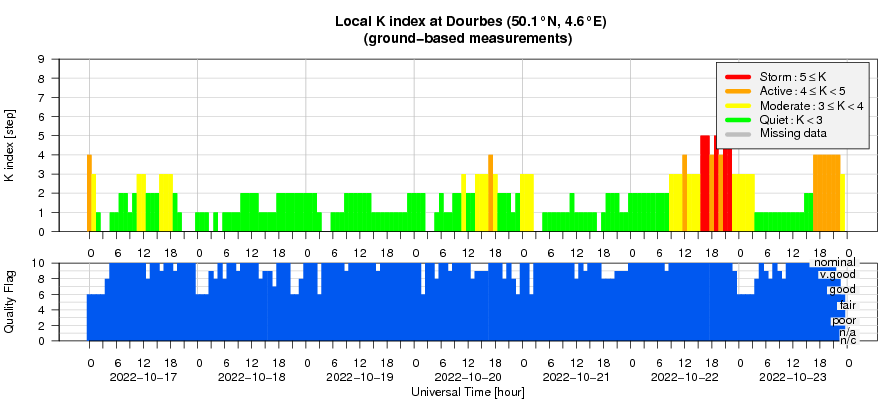- Table of Content
- 1.Close-up of th...
- 2.Gamma Ray Burs...
- 3.Escape from th...
- 4.Review of sola...
- 5.Review of geom...
- 6.The SIDC Space...
- 7.PROBA2 Observa...
- 8.The Internatio...
- 9.Geomagnetic Ob...
- 10.Action!
2. Gamma Ray Burst!
3. Escape from the moon-earth shuttle
4. Review of solar activity
5. Review of geomagnetic activity (17 Oct 2022 - 23 Oct 2022)
6. The SIDC Space Weather Briefing
7. PROBA2 Observations (17 Oct 2022 - 23 Oct 2022)
8. The International Sunspot Index by SILSO
9. Geomagnetic Observations at Dourbes (17 Oct 2022 - 23 Oct 2022)
10. Action!
Close-up of the Sun
Solar Orbiter's unprecedented view of the quiet corona
The ESA-led Solar Orbiter mission has experienced its second close encounter with the Sun. It is delivering more stunning data, and at higher resolution than ever before!
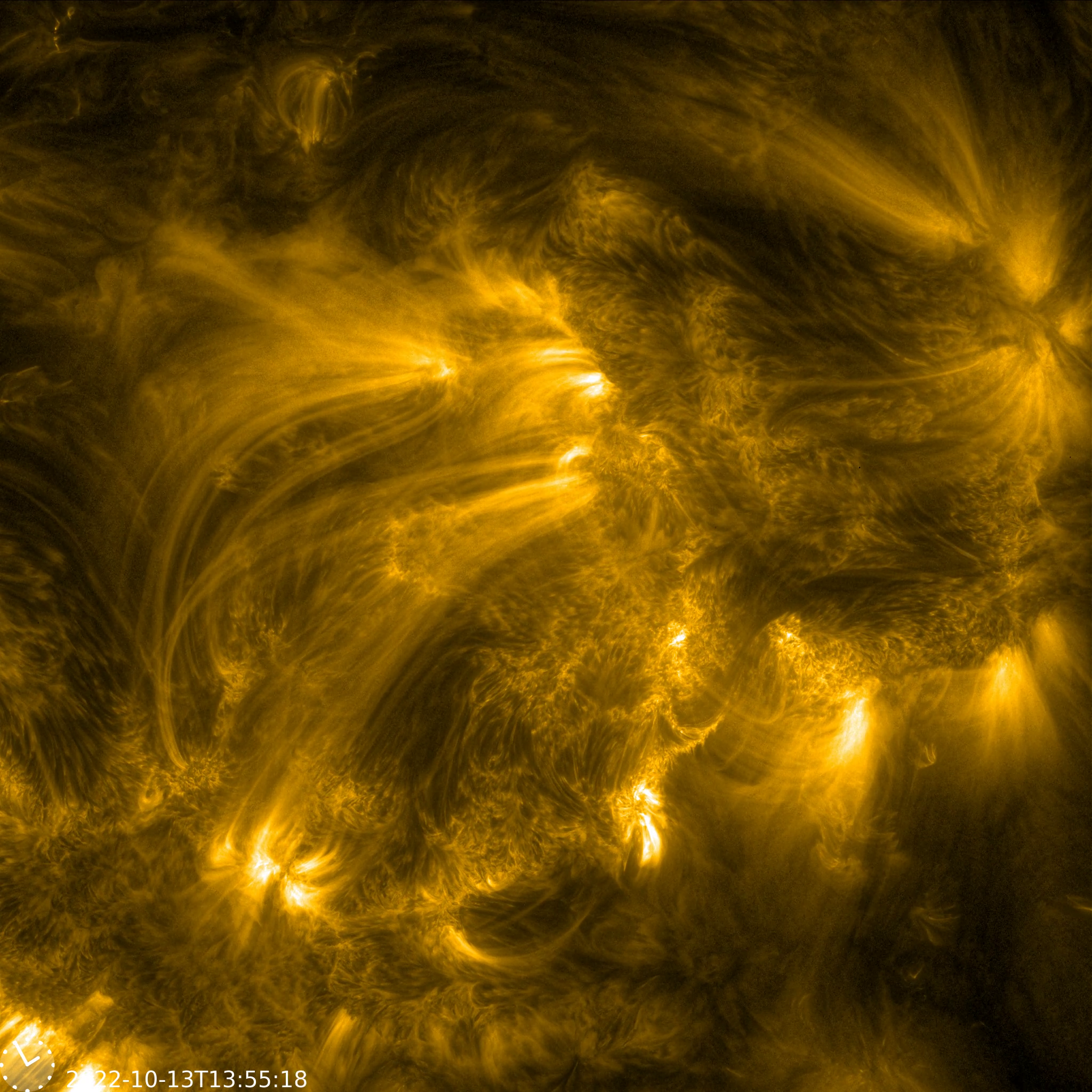
Movie: https://www.stce.be/newsletter/movies/wow_hrieuv_20221013_perihelion.mp4
The moment of closest approach took place on 12 October at 19:12 UTC, when Solar Orbiter was just 29% of the Earth's distance from the Sun. This movie was made on 13 October, when the spacecraft's Extreme Ultraviolet Imager (EUI) returned the highest resolution movie of the quiet corona ever taken with any instrument. It shows the dynamic nature of the Sun's million-degree-hot corona and was enhanced with Wavelet Optimized Whitening technique (Frédéric Auchère, IAS).
The corona is the Sun's outer atmosphere. It is termed quiet when there is little appreciable solar activity such as flares or coronal mass ejections. The Sun is currently ramping up for a peak in its activity levels, known as solar maximum, in 2025. So views of a quiet corona are likely to become rarer in the coming few years.
Each pixel on this movie spans 105 kilometres on the surface of the Sun. This means that if EUI were to look at the Earth from this distance, our entire planet would span just 120 pixels across. The movie itself contains 2048 across, meaning that 17 Earths would fit side by side across this image.
This particular encounter benefited from Solar Orbiter rapidly flying in the direction of Earth. This allowed much more data to be downlinked. It also allowed for co-ordinated observations of solar features to be made with Earth-based telescopes, from 21 October onwards.
More info on the ESA website.: https://www.esa.int/ESA_Multimedia/Videos/2022/10/Solar_Orbiter_s_unprecedented_view_of_the_quiet_corona
Solar Orbiter is a space mission of international collaboration between ESA and NASA, operated by ESA.
Gamma Ray Burst!
Gamma rays are high frequency (higher than x-rays) electromagnetic radiation and as such impart the highest energy to photons. On Earth, gamma rays are known from radio-active decay of atomic nuclei, thunderstorms, nuclear explosions, and as a byproduct from the interaction of cosmic rays with the Earth's atmosphere (e.g. see this NASA/CGRO image at https://imagine.gsfc.nasa.gov/science/featured_science/gamma_earth/ ). Solar flares may also be accompanied by gamma ray emission such as e.g. the X5 flare on 7 March 2012 ( https://fermi.gsfc.nasa.gov/fermi10/fridays/092020a.html ). Occasionally, the solar gamma rays may even be detected if the source location of the flare is on the Sun's farside as seen from Earth (see e.g. NASA/FERMI - https://www.nasa.gov/feature/goddard/2017/nasas-fermi-sees-gamma-rays-from-hidden-solar-flares ). However, the truly astounding gamma ray producers are outside our solar system. Pulsars and magnetars (the highly magnetized collapsed core of massive supergiant stars) are located in our own Milky Way, but even more powerful gamma rays are produced by the active nucleus in other galaxies (think supermassive black holes). The most intense sources of gamma rays are the Gamma Ray Bursts (GRBs), thought to be associated with the collapse of a superheavy (tens of solar masses) parent star into a neutron star or black hole.
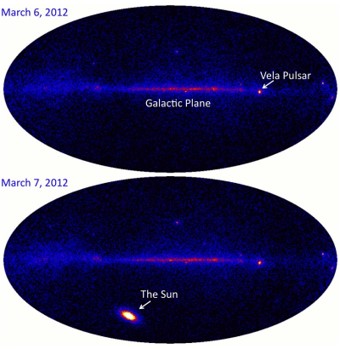
FERMI/LAT all sky gamma ray image on 6 and 7 March 2012, showing the gamma rays associated with the X5 solar flare on 7 March 2012.
On 9 October around 13:20UTC, high-energy detectors on board an array of satellites such as SOHO, Gaia, Integral, FERMI, SWIFT, Wind and BepiColombo observed a sudden and strong increase in gamma rays. An abnormal increase in x-rays was also recorded by the STIX instrument (https://datacenter.stix.i4ds.net/ ) on board Solar Orbiter. The Spectrometer Telescope for Imaging X-rays (STIX) is a hard X-ray imaging spectrometer covering the energy range from 4 to 150 keV, and designed to observe solar flares. Only, as GOES measurements show (underneath), there was no solar flare in soft x-ray going on at that time (stable at C1.3 - light-blue curve). As it turned out, the STIX instrument detected energetic particles that were created after interaction of the high-energetic gamma ray emission with the spacecraft itself.
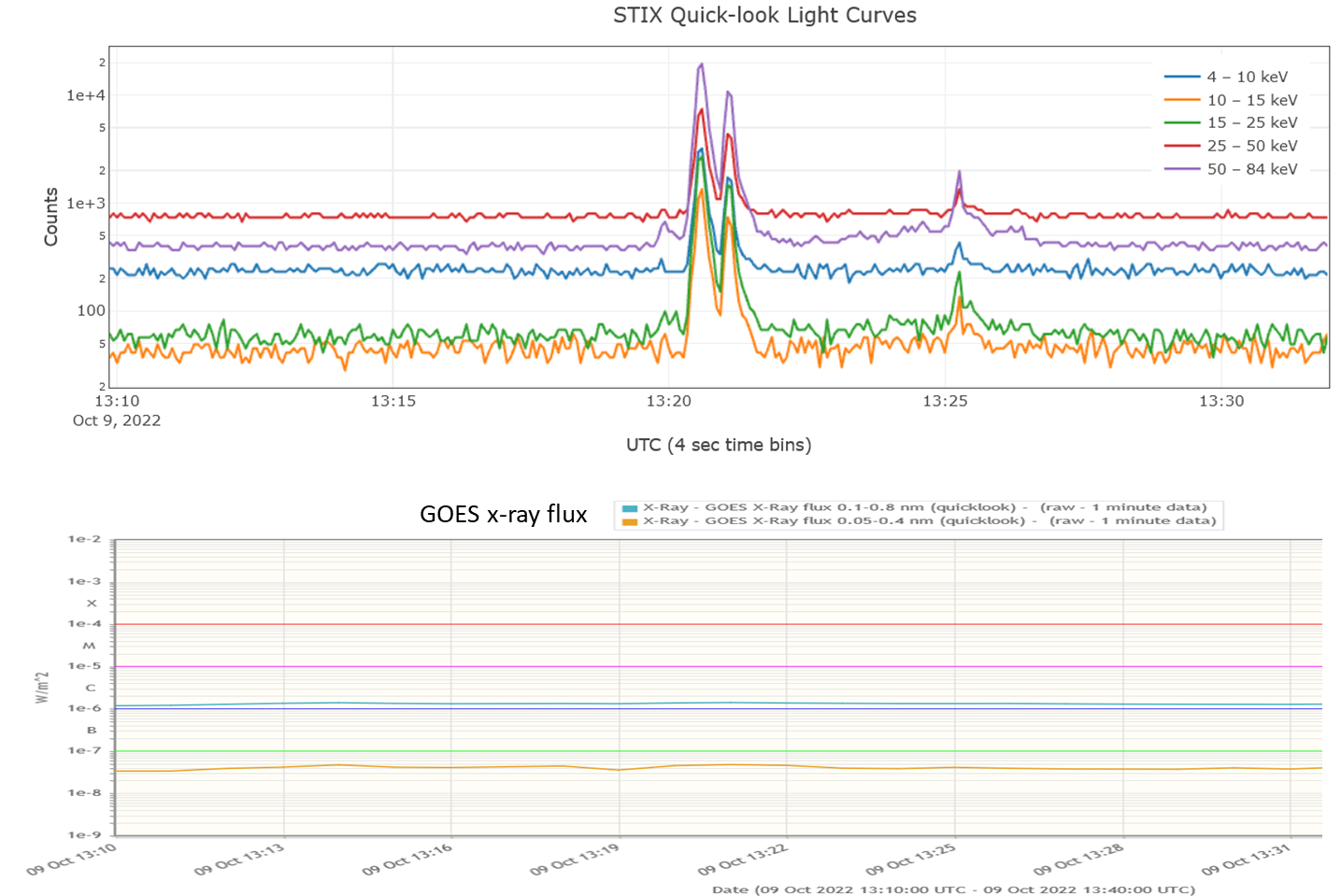
X-ray measurements by Solar Orbiter/STIX (upper graph) and GOES (lower graph) on 9 October (13:10-13:32UTC).
So, from the direct and indirect measurements, it was clear this was an extraordinarily strong gamma ray burst (GRB). Dedicated gamma ray telescopes such as the Fermi Gamma-ray Space Telescope (FERMI for short - https://www.nasa.gov/content/fermi-gamma-ray-space-telescope) and ESA's XMM-Newton (X-ray Multi-Mirror Mission - https://www.esa.int/Science_Exploration/Space_Science/XMM-Newton_overview) were directed to the apparent source of the blast, located in the direction of the constellation Sagitta ("arrow"). The result is a magnificent picture (underneath) of the echo of the burst showing X-rays scattering off interstellar dust in our galaxy in marvelous rings, meaning these rings are not physically related to the explosion.
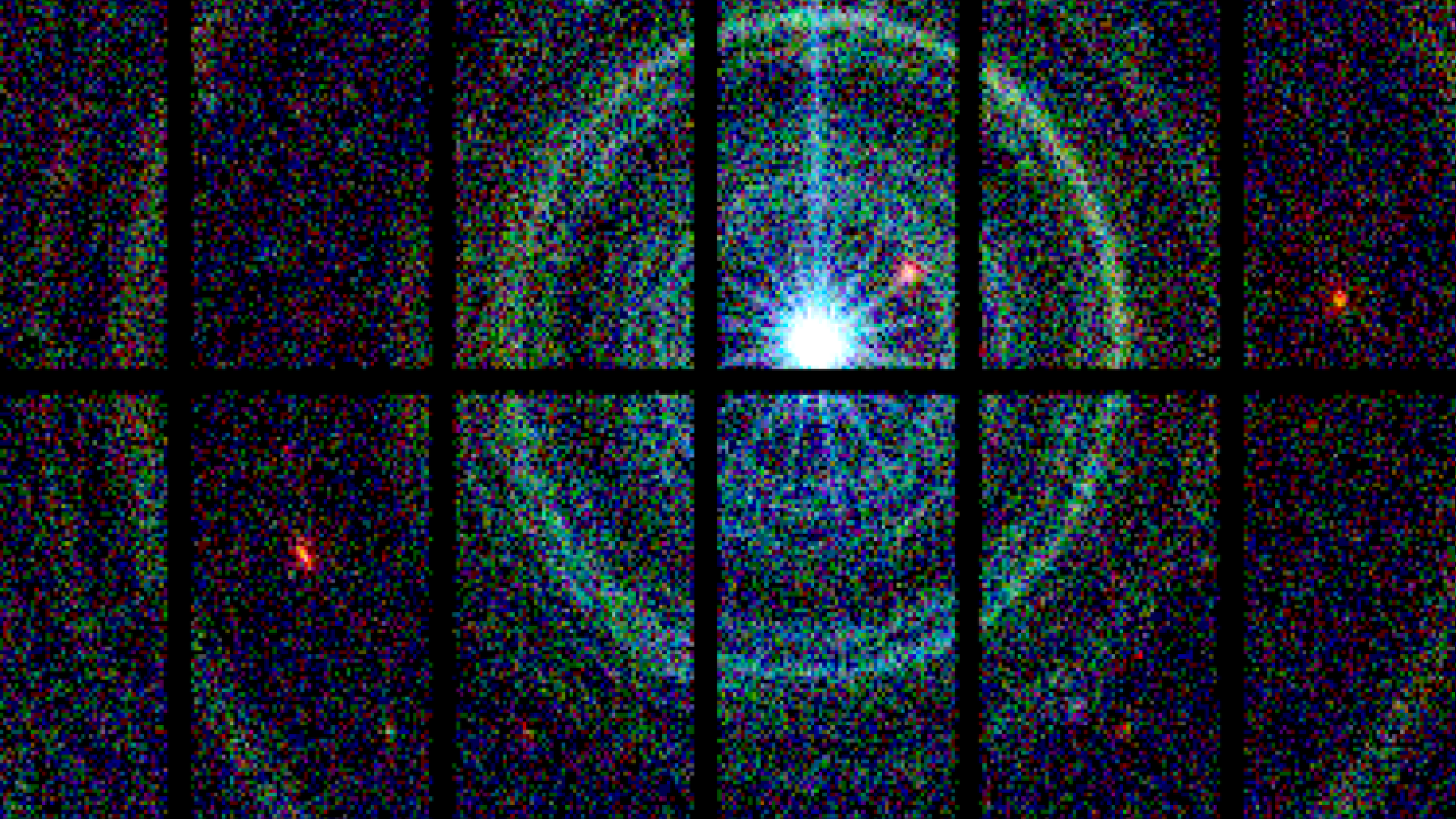
Credit: XMM-Newton
The clip underneath was constructed from images taken by Fermi's Large Area Telescope (LAT) and reveals the sky in gamma rays centered on the location of GRB 221009A (meaning the first ("A") GRB of 2022 October, 9th). Each frame shows gamma rays with energies greater than 100 million electron volts (MeV - Note the STIX data are in keV for observing solar flares...), where brighter colors indicate a stronger gamma ray signal. In total, they represent more than 10 hours of observations, an extremely long duration for a GRB, which typically last only a few minutes. At its maximum, the GRB completely outshined the faint glow from the midplane of our Milky Way galaxy which appears as a wide diagonal band to the left. The image is about 20 degrees across. Current thinking is that GRB 221009A represents the birth of a new black hole formed within the heart of a collapsing star, at an estimated distance of 1.9 billion light years from Earth. This relatively close distance probably contributed to what most likely is the strongest gamma ray burst detected in modern history.
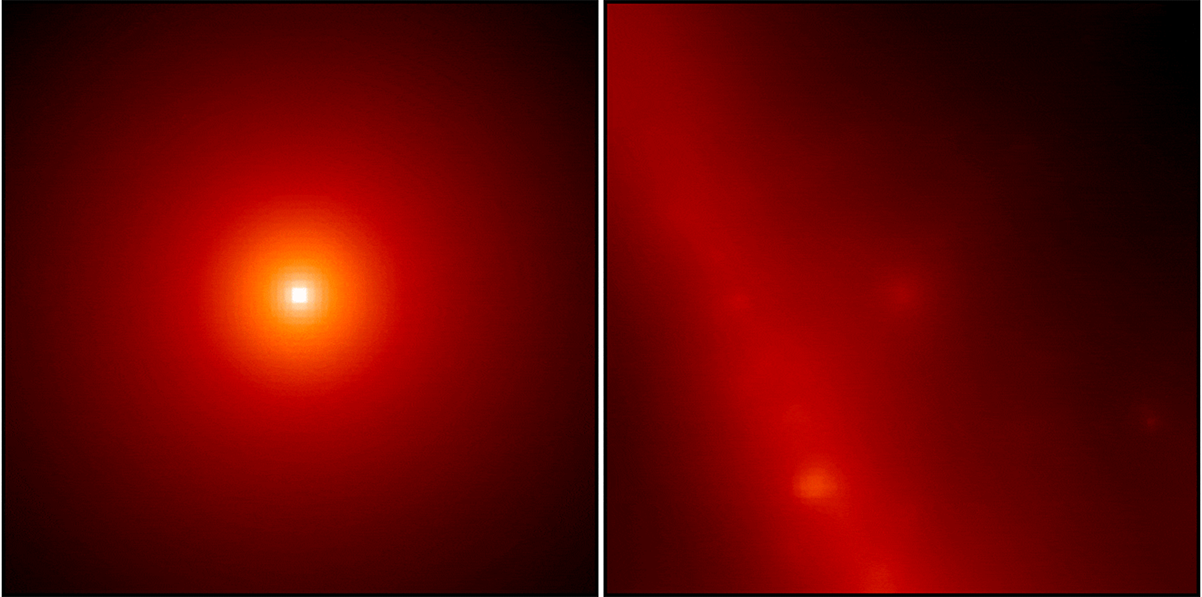
Credit: NASA/DOE/Fermi LAT Collaboration
Not surprizingly, the GRB’s high-energy photons disturbed the Earth's ionosphere and modified its radio-propagation properties. During the gamma ray burst, radio operators detected flickering from multiple stations in VLF (Very Low Frequency) radio signals circling our planet in the Earth-ionosphere waveguide, i.e. where the Earth’s crust forms one of the waveguide’s walls. This allowed the antennas to detect distant transmitters if they were within the GRB radiation footprint, i.e. within the pink line spanning Africa over Asia to Australia as shown in the graph underneath. While GRBs are not common sources of these so-called sudden ionospheric disturbances -the culprits are typically solar flares- some energetic GRBs in the past have left similar imprints. A typical example is the giant gamma ray *flare* (not a GRB!) on magnetar SGR 1806–20 that occurred on 27 December 2004. It massively affected the daytime lower ionosphere down to about 20 km altitude for more than an hour, resulting in very similar VLF effects as the GRB 221009A (Inan et al., 2007 - https://doi.org/10.1029/2006GL029145 ). Though that gamma ray "burst" was a lot less energetic than GRB 221009A, it also happened much closer to home, in our very own galaxy, at a distance of only 50.000 light years. Researchers have theorized that a genuine GRB within let's say about 10.000 light years from the Earth would quickly deplete much of the Earth's protective ozone layer, allowing an increase in solar UVB (ultraviolet B) radiation reaching the surface. This radiation is harmful to life, damaging DNA and causing sunburn. In addition, NO2 produced in the atmosphere would cause a decrease in visible sunlight reaching the surface and could cause global cooling (Thomas et al. 2005 - https://doi.org/10.1086/496914 ). The good thing is that there are no obvious candidates for such a GRB near our solar system, and thus that we "only" have to keep an eye on the occasional gamma ray flares that may occur on hyper-dense, hyper-magnetized star remnants such as magnetars. But even then, it's definitely not the kind of neighbour you want to be close with!
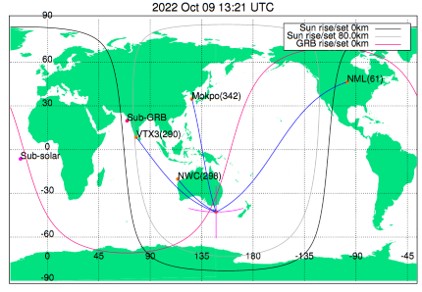
Credit: Dr Andrew Klekociuk and Spaceweather.com - VLF signals were received in Tasmania from stations in India and South-Korea (within the GRB imprint), but not from USA (outside the imprint).
Sources and further reading: ESA (https://www.esa.int/ESA_Multimedia/Images/2022/10/ESA_spacecraft_catch_the_brightest_ever_gamma-ray_burst ), NASA (https://www.nasa.gov/feature/goddard/2022/nasa-s-swift-fermi-missions-detect-exceptional-cosmic-blast ), and Spaceweather.com (https://spaceweatherarchive.com/2022/10/17/powerful-gamma-ray-burst-made-currents-flow-in-the-earth/ ).
Escape from the moon-earth shuttle
European Space Weather Week is at its full swing. We made a flying start on Monday and we keep on going.
Although ... some people didn't make it because they got stuck on the moon.
The story goes like this
Speaker: "A team of scientists and engineers are in the Moon-Earth shuttle that is about to leave the Lunar Orbiting Platform-Gateway. They spent 1 month on the Moon to prepare the very first journey to Mars. They are looking forward to seeing their family and friends again on our blue planet."

The atmosphere is relaxed. In a few hours, they will re-enter the Earth’s atmosphere. Everything is going smoothly.
You hear people chit chatting, talking about their children, what they will do when they are back home.
A few tiny clicks. A second later the debris alarm goes off.
Moontraveller 1 in the Moon-Earth shuttle: "We were hit by a particle storm. We have to check the damage immediately."
Sound of a turning wheel, a door that opens, beeps
Moontraveller 2 in the Moon-Earth shuttle:
"A cluster of energetic solar particles hit the computer module of the moon-earth shuttle. The computer gave a false command to disconnect from the Lunar Orbiting Platform-Gateway in 30 minutes. This is too early. We will be launched into a sun-grazing orbit! We have to break into the computer to reset it. Where are the security numbers?! We have 30 minutes to insert the 5-digit code."
Several didn't make it, little could keep their head cool and managed to escape. These five people survived.

Review of solar activity
Flares
Solar activity was at low levels over the past week, with a C6.4 flare, peak time on 22 October 05:42 UTC, from beyond the west limb being the flare with the largest X-ray output. There were eleven active regions present on the solar disc during the week, most of them of small complexity and fairly stable. Of most interest was NOAA AR 3122 which dominated the flaring activity when it reached the west limb.
Coronal Mass Ejection
A Coronal Mass Ejection was observed in Lasco/C2 data on 21 October 04:49 UTC, associated with a radio pulse on 21 October 04:08 UTC and a C1.6 flare, peak time 21 October 04:32 UTC from NOAA active region 3126 as well as an EUV wave was reported.
Solar Energetic Particles
The greater than 10 MeV proton flux was at nominal levels over the week. The greater than 2MeV electron flux remained mainly below the 1000 pfu threshold, crossing it for a small period of time on 20 and 21 October. Similarly, the 24h electron fluence started was at nominal levels for the majority of the week as well.
Review of geomagnetic activity (17 Oct 2022 - 23 Oct 2022)
At the start of the week the solar wind parameters reflected waning high speed stream influences. After returning to background levels at the middle of the week, the arrival of the high speed stream associated with the negative polarity coronal hole, which began to cross the central meridian on October 20 led the solar wind speed back to values of 600 km/s.
Geomagnetic conditions reached minor storm conditions at the time of the high speed stream arrival (NOAA Kp=Local K Dourbes 5).
The SIDC Space Weather Briefing
The Space Weather Briefing presented by the forecaster on duty from Oct 16 to 23. It reflects in images and graphs what is written in the Solar and Geomagnetic Activity report: https://www.stce.be/briefings/20221024_SWbriefing.pdf
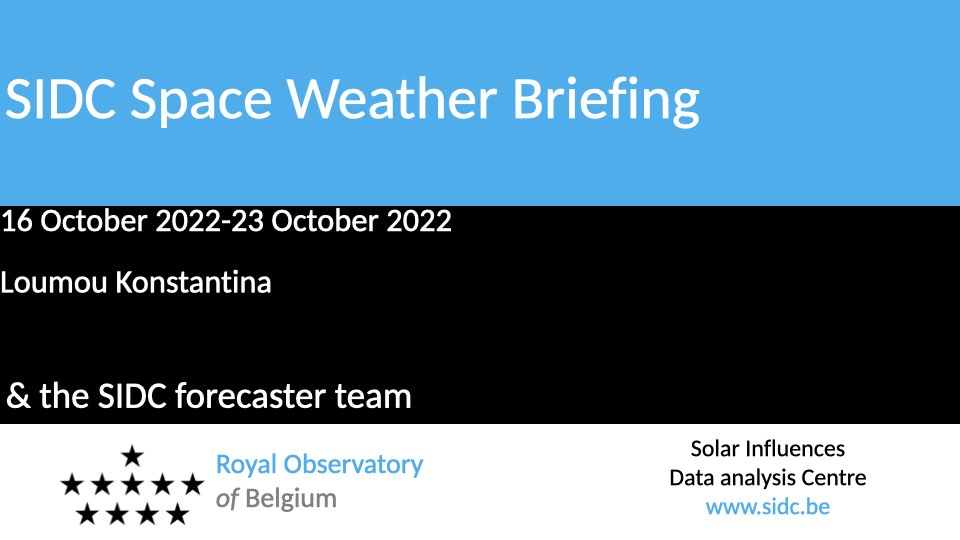
If you need to access the movies, contact us: stce_coordination at stce.be
PROBA2 Observations (17 Oct 2022 - 23 Oct 2022)
Solar Activity
Solar flare activity was low during the week.
In order to view the activity of this week in more detail, we suggest to go to the following website from which all the daily (normal and difference) movies can be accessed: https://proba2.oma.be/ssa
This page also lists the recorded flaring events.
A weekly overview movie can be found here (SWAP week 656).
https://proba2.sidc.be/swap/data/mpg/movies/weekly_movies/weekly_movie_2022_10_17.mp4
Details about some of this week's events can be found further below.
If any of the linked movies are unavailable they can be found in the P2SC movie repository here
https://proba2.sidc.be/swap/data/mpg/movies/
Saturday 22
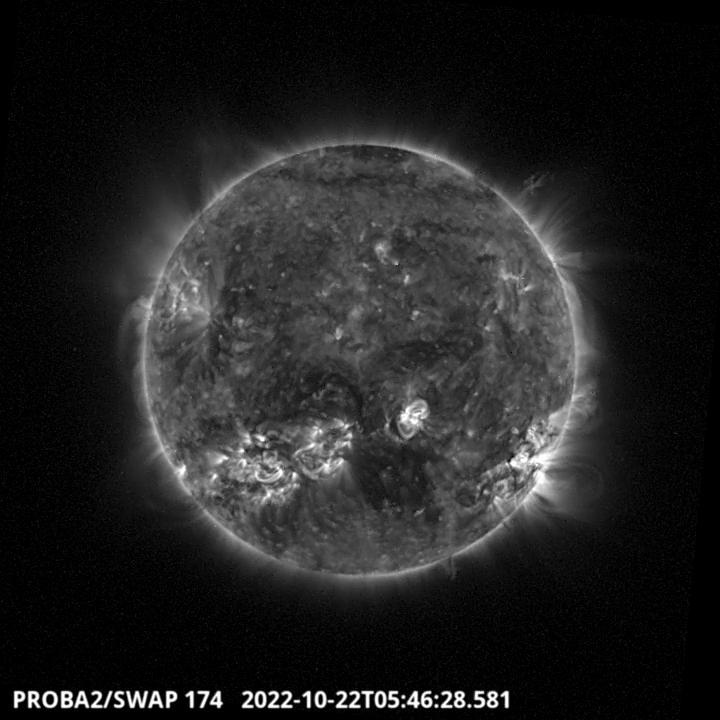
The largest flow of the week occured in the South-West Quadrant around 5:46 UT on October 22.
It was associated to a C6.4 flare - SWAP image. Find a movie of the events here (SWAP movie)
https://proba2.sidc.be/swap/data/mpg/movies/20221022_swap_movie.mp4
The International Sunspot Index by SILSO
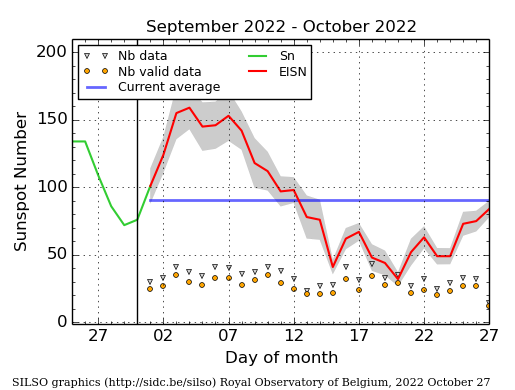
The daily Estimated International Sunspot Number (EISN, red curve with shaded error) derived by a simplified method from real-time data from the worldwide SILSO network. It extends the official Sunspot Number from the full processing of the preceding month (green line), a few days more than one solar rotation. The horizontal blue line shows the current monthly average. The yellow dots give the number of stations that provided valid data. Valid data are used to calculate the EISN.
Action!
Check out our activity calendar: activities and encounters with the Sun-Space-Earth system and Space Weather as the main theme. We provide occasions to get submerged in our world through educational, informative and instructive activities.
If you want your event in our calendar, contact us: stce_coordination at stce.be
* October 19, seminar: Detecting Europa’s Water Plumes, onsite and online, Royal Observatory of Belgium
* October 20, seminar: The effect of flux rope heating models on solar prominence formation, onsite and online, CmPA, Leuven, Belgium
* October 20, Job vacancy EUI onboard Solar Orbiter - last day for submission
* October 24-28, 18th European Space Weather Week, Zagreb, Croatia
* October 27, ROB Astronomy and Astrophysics seminar: "The results of the digitization of the Pulkovo Observatory astronegative archive"
* November 8, CmPA seminar: "From the pre-eruption state in the Sun to the propagation of eruption products in the inner heliosphere and beyond: connecting some dots", onsite and online, CmPA
* November 21-23, Space Weather Introductory Course - onsite, by the STCE, Brussels, Belgium - fully booked
* November 22, seminar: Ionospheric Disturbances Detection by HF Doppler sounding, onsite and online, STCE
* November 27, Dag van de Wetenschap, Planetarium, Belgium
* December 5, 6, 8, 9, Space Weather Introductory Course - online, by the STCE, zoom - fully booked
Check: https://www.stce.be/calendar

